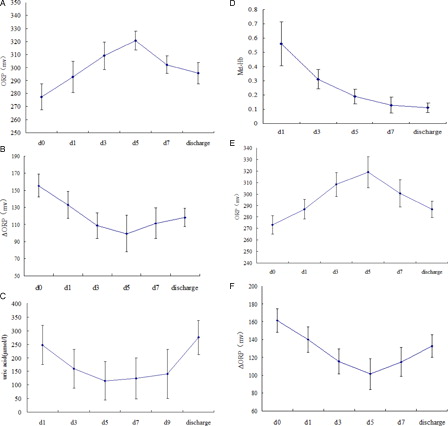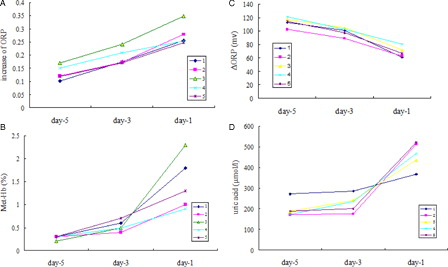Figures & data
Table 1. Demographic and clinical characteristics of the cohort of 30 severe burn patients
Table 2. Demographic and clinical characteristics of the cohort of 20 mild burn patients
Table 3. Stability of measurements using the depolarization curve method and improved traditional method using blood samples from a healthy person or redox reference solution
Table 4. Stability of measurements of the depolarization curve method using plasma samples from eight mild burn patients
Table 5. Stability of measurements of the depolarization curve method using diluted plasma samples from eight mild burn patients
Table 6. Electrochemical specificity of the depolarization curve method in KMnO4/vitamin C redox titration experiments
Table 7. Electrochemical specificity of the improved traditional method in KMnO4/Vitamin C redox titration experiments
Figure 1. (A) Changes in the ORP in 15 severe burn patients without early Escher-shaving operation during the shock stage. (B) Changes in the ΔORP in 15 severe burn patients without early Escher-shaving operation during the shock stage. (C) Changes in the UA levels in 15 severe burn patients without early Escher-shaving operation during the shock stage. (D) Changes in the methemoglobin (Met-Hb) levels in 23 severe burn patients (with and without early Eschar-shaving operation) during the shock stage. (E) Changes in the ORP in 8 severe burn patients who underwent early Eschar-shaving operations during the shock stage. (F) Changes in the ΔORP in eight severe burn patients who underwent early Eschar-shaving operations during the shock stage. The known group validity according to dynamic monitoring of the ORP, ΔORP, uric acid level and methemoglobin (Met-Hb) content of plasma samples from 23 severe burn patients (with and without early Escher-shaving operation) during the shock stage is shown. For the ORP, diluted plasma samples (1 ml of plasma + 3 ml of normal saline) were used. For the ΔORP, uric acid level and methemoglobin (Met-Hb) content, plasma samples were used. Plasma samples were consecutively collected from 23 severe burn patients for approximately 7 days before and after fluid treatment during the shock stage (mean ± SD). The data are presented according to the time of day: d0 (within six hours after injury, no anti-shock fluid treatment had been administered), d1 (1 day after injury and anti-shock fluid treatment), and d3, d5, d7, and d9 (3, 5, 7, and 9 days after injury and anti-shock fluid treatment, respectively). Discharge represents the data at discharge. The abscissa axis is time (day). The close correlations between the plasma ORP and ΔORP measurements and the UA levels were confirmed (P < 0.05).

Figure 2. (A) Dynamic changes in the ORP (compared with d0) in five severe burn patients in late sepsis. (B) Dynamic changes in the Met-Hb levels in five severe burn patients in late sepsis. (C) Dynamic changes in the ΔORP in five severe burn patients in late sepsis. (D) Dynamic changes in the uric acid levels in five severe burn patients in late sepsis. The known group validity according to the dynamic monitoring of the ORP, ΔORP, uric acid level and methemoglobin (Met-Hb) content of plasma samples of five severe burn patients in late sepsis prior to death is shown. For the ORP, diluted plasma samples (1 ml of plasma + 3 ml normal saline) were used. For the ΔORP, uric acid level and methemoglobin (Met-Hb) content, plasma samples were used. Plasma samples were consecutively collected from five severe burn patients in late sepsis prior to death. The data are presented by the time of day: day 1 (one day before death), day 3 (the third day before death), and day 5 (the fifth day before death). The abscissa axis is time (day). The change trend along with progress of disease is shown.
